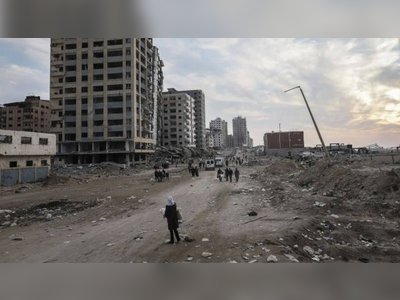
Survivors Reflect on the 1982 Hama Massacre as Assad's Regime Faces Scrutiny
40 years after the brutal crackdown in Hama, survivors recount the violent suppression by Assad’s forces, with death toll estimates ranging from 10,000 to 40,000.
In February 1982, Syria’s Hama city became the site of a violent crackdown by the forces of then-President Hafez al-Assad, aimed at quelling an armed revolt by the Muslim Brotherhood.
The 27-day siege, carried out with extreme force, led to significant loss of life and widespread destruction.
Survivors of the massacre, who have remained silent for decades, have now shared their experiences in the wake of recent political changes following the ouster of Bashar Assad.
Hayan Hadid, now a father of five, was just 18 when he was arrested by soldiers and nearly executed during the crackdown.
Despite not having any ties to the Muslim Brotherhood, Hadid, like many others, was caught in the violence that saw both combatants and civilians targeted.
After being taken with 40 other men to a cemetery, Hadid miraculously survived a barrage of gunfire by instinctively dropping to the ground.
He managed to escape and eventually reached safety.
The true scale of the massacre remains difficult to ascertain, as the Syrian government imposed an information blackout during the violence.
Estimates of the death toll vary widely, with figures ranging from 10,000 to 40,000, though some sources suggest the number may be higher.
Camellia Boutros, who worked at Hama’s hospital during the period, recalled overwhelming numbers of bodies arriving by truck.
According to Boutros, the bodies of 32,000 civilians were recorded, alongside 7,000 soldiers and 5,000 Muslim Brotherhood members.
The government reportedly sought regular updates on the death toll but never acknowledged the full extent of the violence.
Bassam Al-Saraj, another survivor, lost his brother in the massacre.
Al-Saraj described how his brother was executed in front of his family.
His memories of the crackdown are marked by images of entire neighborhoods being targeted, with no regard for age, gender, or affiliation.
Similar testimonies from other survivors recount the arbitrary and widespread killings, including women, children, and non-Sunni individuals.
Mohammed Qattan, a former member of the Fighting Vanguard, a group linked to the Brotherhood, recalled how his own family suffered losses during the crackdown.
After fighting in Hama, Qattan was arrested and imprisoned for 12 years.
He described the government’s approach to quelling the rebellion as one of indiscriminate violence, noting that the streets were littered with bodies, including those of civilians.
While the victims of the Hama massacre included both Brotherhood members and non-affiliated individuals, the incident remains one of the most brutal episodes in the Assad regime’s history.
The crackdown is seen as a pivotal moment in the consolidation of the Assad family's power, with lasting repercussions for Syria’s political landscape.
In the years since, the Syrian government has never fully acknowledged the scale of the atrocities committed in Hama.
However, as survivors share their stories following Assad’s recent ouster, the massacre remains a stark reminder of the regime’s willingness to use extreme measures to suppress dissent and maintain control.
The 27-day siege, carried out with extreme force, led to significant loss of life and widespread destruction.
Survivors of the massacre, who have remained silent for decades, have now shared their experiences in the wake of recent political changes following the ouster of Bashar Assad.
Hayan Hadid, now a father of five, was just 18 when he was arrested by soldiers and nearly executed during the crackdown.
Despite not having any ties to the Muslim Brotherhood, Hadid, like many others, was caught in the violence that saw both combatants and civilians targeted.
After being taken with 40 other men to a cemetery, Hadid miraculously survived a barrage of gunfire by instinctively dropping to the ground.
He managed to escape and eventually reached safety.
The true scale of the massacre remains difficult to ascertain, as the Syrian government imposed an information blackout during the violence.
Estimates of the death toll vary widely, with figures ranging from 10,000 to 40,000, though some sources suggest the number may be higher.
Camellia Boutros, who worked at Hama’s hospital during the period, recalled overwhelming numbers of bodies arriving by truck.
According to Boutros, the bodies of 32,000 civilians were recorded, alongside 7,000 soldiers and 5,000 Muslim Brotherhood members.
The government reportedly sought regular updates on the death toll but never acknowledged the full extent of the violence.
Bassam Al-Saraj, another survivor, lost his brother in the massacre.
Al-Saraj described how his brother was executed in front of his family.
His memories of the crackdown are marked by images of entire neighborhoods being targeted, with no regard for age, gender, or affiliation.
Similar testimonies from other survivors recount the arbitrary and widespread killings, including women, children, and non-Sunni individuals.
Mohammed Qattan, a former member of the Fighting Vanguard, a group linked to the Brotherhood, recalled how his own family suffered losses during the crackdown.
After fighting in Hama, Qattan was arrested and imprisoned for 12 years.
He described the government’s approach to quelling the rebellion as one of indiscriminate violence, noting that the streets were littered with bodies, including those of civilians.
While the victims of the Hama massacre included both Brotherhood members and non-affiliated individuals, the incident remains one of the most brutal episodes in the Assad regime’s history.
The crackdown is seen as a pivotal moment in the consolidation of the Assad family's power, with lasting repercussions for Syria’s political landscape.
In the years since, the Syrian government has never fully acknowledged the scale of the atrocities committed in Hama.
However, as survivors share their stories following Assad’s recent ouster, the massacre remains a stark reminder of the regime’s willingness to use extreme measures to suppress dissent and maintain control.










